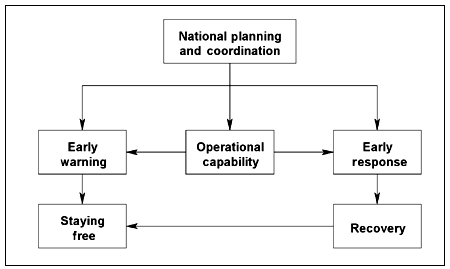Infectious disease emergencies may arise within a country in a number of ways, for example, via incursions of known exotic diseases, through sudden changes in the behaviour of existing endemic diseases or by the appearance of previously unrecognized diseases. Early detection and rapid response are critical to the effective management of such disease emergencies. These depend on an aquatic animal disease prevention programme aimed at surveillance of vulnerable resources for disease outbreaks with a strong diagnostic capability to distinguish diseases of concern from recurrent endemic, husbandry or environmentally induced disease losses. A strong national approach is required to ensure that the necessary operational capability is in place so that early detection and effective responses are achieved. Assessment of the success of an emergency disease response requires measures to ensure that freedom from the particular disease has been achieved. Figure 1 shows the linkages among the different components of a comprehensive emergency preparedness and response plan. Each is explained in more detail in the following sections.
FIGURE 1
Framework for emergency disease preparedness and response (Baldock, 2005)
